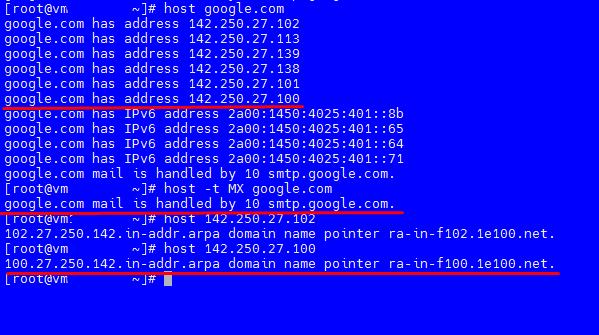When the host command can be useful:
- When diagnosing errors with network connectivity and DNS servers.
- When checking for the presence and correctness of DNS records for your domain.
- When trying to find out the IP address of a site by its domain name or vice versa.
- When working with mail servers and checking MX records for domains.
Resolution of domain names to IP addresses (Domain Name Lookup, DNS Resolution):
By entering a domain name after the host command, you will get the corresponding IP address to which this domain name is bound. This is the A-record for this domain in DNS hosting. Example:
host example.comWhere instead of example.com - specify your domain. The output might look like this:
example.com has address 11.22.33.44
example.com has IPv6 address 2606:2800:220:1:248:1893:25c8:1946
Reverse resolution of IP addresses to domain names (Reverse DNS Lookup).
By entering an IP address after the host command, you will get the domain names associated with that IP address. Example:
host 11.22.33.44
The output might look like this:
44.33.22.11.in-addr.arpa domain name pointer example.com.Reverse DNS Lookup is the process of converting an IP address into its corresponding domain name. In DNS, this is achieved through special reverse DNS records, which are designed to link IP addresses and domain names. This is mainly done with a PTR (Pointer Record) record.
Checking for DNS Records.
The host command can also be useful for checking the presence of various DNS records such as MX (for mail servers), NS (name servers), PTR (reverse records), TXT, and others. TXT, MX and NS are different types of DNS records used to store different information about domain names.
- TXT Record (Text Record): A TXT record is designed to store arbitrary text content associated with a domain name. It can be used for various purposes such as providing information for authentication, documenting security policies, pointing to the owner of a domain, and so on. TXT records are sometimes used to establish domain validation (for SPF, DKIM, DMARC), anti-spam filtering, and other services.
- MX record (Mail Exchange Record): The MX record is used to specify the mail servers that handle email for the domain. MX records define the priority and addresses of electronic mail servers that receive and process mail for a given domain. This allows the email to be routed correctly.
- NS record (Name Server Record): The NS record points to the name servers (DNS servers) responsible for managing the domain zone. NS records define authoritative DNS servers for a domain that can provide information about that domain's DNS records. When someone requests information about a domain, the DNS servers listed in the NS records provide the relevant data.
For example, then the command would look like:
host -t MX example.com
The output will show the MX records for the specified domain. For example, checking MX records for Google:

You can view TXT, MX, NS records of the domain you are interested in:

Conclusions.
- You can use host to see if a domain name resolves to an IP address, and vice versa. This can help in diagnosing errors with DNS records or settings.
- You can use host to check for various DNS records such as MX, NS, TXT and others associated with domains. This is useful for checking if your DNS settings are correct.
- The host command can help you find out information about domain names and their IP addresses, as well as other records associated with domains.
In general, the host command provides a quick and convenient way to get information about DNS relationships between domain names and IP addresses, which can be useful for server administration and web development.

